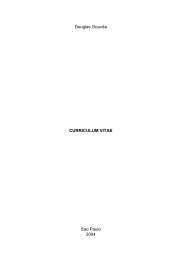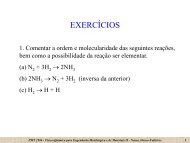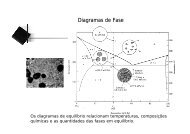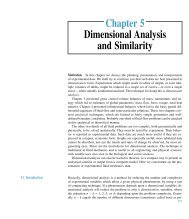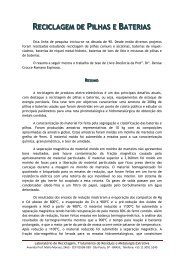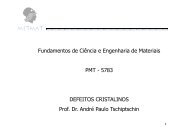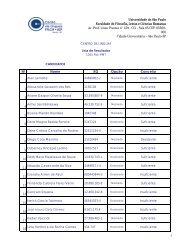The Use of a Vickers Indenter in Depth Sensing Indentation for ...
The Use of a Vickers Indenter in Depth Sensing Indentation for ...
The Use of a Vickers Indenter in Depth Sensing Indentation for ...
Create successful ePaper yourself
Turn your PDF publications into a flip-book with our unique Google optimized e-Paper software.
Vol. 7, No. 3, 2004 <strong>The</strong> <strong>Use</strong> <strong>of</strong> a <strong>Vickers</strong> <strong>Indenter</strong> <strong>in</strong> <strong>Depth</strong> Sens<strong>in</strong>g <strong>Indentation</strong> 489<br />
<strong>for</strong> Measur<strong>in</strong>g Elastic Modulus and <strong>Vickers</strong> Hardness<br />
Table 3. Comparison <strong>of</strong> elastic moduli measured by means <strong>of</strong> the analysis procedure based on Oliver Pharr method with those given by<br />
Fischerscope mach<strong>in</strong>e. Each measurement corresponds to the average <strong>of</strong> twenty curves.<br />
Material Load, mN Experimental modulus Experimental modulus Literature<br />
(new rout<strong>in</strong>e), GPa (Fischer S<strong>of</strong>tware), GPa modulus, GPa<br />
WC-12%Co 50 477 ± 49 526± 61 490<br />
100 481 ± 42 509± 40<br />
TiN 30 411 ± 20 510 ± 30 417 (111)<br />
Al 2<br />
O 3<br />
(99.8%) 50 380 ± 18 442 ± 19 375, 393<br />
500 378 ± 06 410 ± 06<br />
1000 379 ± 05 405 ± 05<br />
Co-25%Cr 100 209 ± 10 230 ±10 211<br />
500 208 ± 10 210 ±10<br />
H13 tool steel 50 208 ± 07 220 ± 07 210<br />
500 207 ± 07 210 ± 05<br />
D2 tool steel 100 206 ± 07 230 ± 05 207<br />
700 207 ± 05 215 ± 07<br />
AISI 316 500 196 ± 08 182 ± 08 192, 195<br />
sta<strong>in</strong>less steel 750 197 ± 06 189 ± 6<br />
Alum<strong>in</strong>um 40 70 ± 02 69 ± 02 70.4<br />
80 69 ± 02 68 ± 02<br />
255 70 ± 02 68 ± 02<br />
750 69 ± 03 65 ± 03<br />
Au-12%Pt 100 81 ± 04 80 ± 02 77<br />
Au (99.98%) 10 77 ± 06 74 ± 02 77<br />
Soda-lime glass 5 68 ± 02 79 ± 02 69.9<br />
10 69 ± 01 78 ± 01<br />
50 70 ± 01 80 ± 01<br />
500 70 80<br />
1000 71 80<br />
the Oliver and Pharr method gives elastic moduli practical<br />
<strong>in</strong>dependent <strong>of</strong> the applied load, as one can see <strong>in</strong> Table 3.<br />
4.2. <strong>Vickers</strong> Hardness<br />
Figure 8 shows a set <strong>of</strong> measurements undertaken 5, 15,<br />
25 and 35 µm beneath the nitrided surface <strong>of</strong> a H13 tool steel<br />
specimen and Table 4 compares the diagonals measured by<br />
image analysis with those determ<strong>in</strong>ed by means <strong>of</strong> Eq. 13,<br />
based on the calculated S and E r<br />
values. It can be seen that<br />
the values given by both methods are very close.<br />
Even <strong>in</strong> the case <strong>of</strong> large <strong>in</strong>dentations (Fig. 9), the measured<br />
hardness values are <strong>in</strong> good agreement with those determ<strong>in</strong>ed<br />
us<strong>in</strong>g Eq. 13, as can be seen <strong>in</strong> Table 5.<br />
F<strong>in</strong>ally, Table 6 shows the <strong>Vickers</strong> hardness numbers<br />
determ<strong>in</strong>ed through the proposed rout<strong>in</strong>e <strong>for</strong> different materials<br />
present<strong>in</strong>g different elastic-plastic behaviors and <strong>in</strong><br />
some cases obta<strong>in</strong>ed with different applied loads. <strong>The</strong> hardness<br />
values shown <strong>in</strong> Table 6 agree fairly well with the<br />
well-known <strong>Vickers</strong> hardness numbers <strong>of</strong> the different listed<br />
materials.<br />
<strong>The</strong>re<strong>for</strong>e, artifacts <strong>in</strong> the measurements <strong>of</strong> the <strong>Vickers</strong><br />
hardness ow<strong>in</strong>g to ISE effect alone can be ruled out. <strong>The</strong><br />
new rout<strong>in</strong>e adapted to Fischerscope - depth sens<strong>in</strong>g <strong>in</strong>dentation<br />
apparatus allows measur<strong>in</strong>g <strong>Vickers</strong> hardness <strong>of</strong><br />
tribological coat<strong>in</strong>gs us<strong>in</strong>g very low loads without the necessity<br />
to derive expressions that relate coat<strong>in</strong>g hardness to<br />
substrate hardness, and to deal with the composite response<br />
<strong>of</strong> film and substrate.<br />
5. Conclusion<br />
• <strong>The</strong> proposed rout<strong>in</strong>e gives a better estimate <strong>of</strong> elastic<br />
moduli <strong>of</strong> materials, when compared to the values<br />
given by the equipment s<strong>of</strong>tware.<br />
• <strong>The</strong> lesser the load, the greater are the differences<br />
between the two methods.<br />
• Very low loads can be used <strong>for</strong> determ<strong>in</strong><strong>in</strong>g elastic<br />
moduli <strong>of</strong> very th<strong>in</strong> layers, as the ISE effect was m<strong>in</strong>imized.<br />
• <strong>The</strong> elastic contact theory equations and the Oliver-<br />
Pharr approach <strong>of</strong>fer an optimum prediction <strong>of</strong> the<br />
<strong>in</strong>dentation diagonals and, consequently, <strong>of</strong> the<br />
<strong>Vickers</strong> hardness numbers <strong>of</strong> the tested materials.



